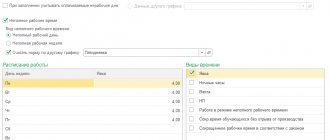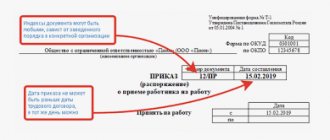Part-time work is a phenomenon that occurs all the time. The desire to earn extra money, especially if the salary at the main place is not too high, is natural for every person. And if for an employee everything is simple and clear: he found a second job, a selection came and began performing the assigned functions, then for the personnel department the question arises: how to register a part-time worker.
How to formalize the transfer of an internal part-time worker to the main employees?
Part-time work: highlights
Let's start with the fact that there are two types of part-time work: external and internal. External is when an employee does not work in the organization, but comes as a part-time employee from outside. In case of internal combination, an employee who is on the company’s staff is involved in performing tasks.
Question: Is it possible to arrange external part-time work with an employee during maternity leave to maintain her right to receive benefits? View answer
For internal and external combination, it is important that a number of conditions are met. In particular, formality and regularity of work, decent wages and time free from main activities. At the same time, each employee has the right to perform as many additional duties as he can physically handle - in this case, the law does not provide for any restrictions.
The main difference between internal and external part-time workers is the paperwork when applying for a second job.
Question: The employer offers the employee to temporarily perform work in a vacant position in the organization until the relevant employee is hired. Is the employee entitled to receive a salary for the position being filled? In what order should an employee be registered (part-time work, increasing the amount of work)? View answer
What is part-time work? Key points
Part-time work is the performance by an employee of regular paid work under the terms of an employment contract in his free time from his main job (Article 282 of the Labor Code of the Russian Federation).
Key points when working part-time:
- The duration of the working day should not be more than 4 hours. Exceptions are possible in two cases: on a day when the employee is free from his main job and when his main job has a day off.
- labor must be paid in proportion to the time worked (Article 285 of the Labor Code of the Russian Federation)
Internal alignment: the essence
The peculiarity of internal combination is that an employee can combine work while in the same position. This practice is common, for example, among teachers and professors, when they teach part of the classes in one subject and part in another. Most often, internal combinations occur at the request of employees, which management willingly supports: hiring a person you already know well is much more profitable and productive than hiring a stranger.
Question: Is it possible to register a part-time employee with the same employer for temporary work (up to 2 months)? What is the correct way to then indicate in the dismissal order that only one fixed-term employment contract is terminated and the main one continues to be valid? View answer
What is the difference between internal and external part-time work?
In order to understand the concepts related to the issues of what internal part-time work and combination work are, what is the difference between them, the employer will have to understand the legislative theory regulating the relationship between the parties to the employment agreement.
The differences lie in the fact that with part-time work, the work is performed during time that is free from the main job, and with combination work, the employee will have to find time to solve additional tasks during the time period regulated by the working day. The personnel inspector is required to fill out a monthly time sheet separately for part-time workers, even in situations where they work at the same enterprise. When combining positions, as well as when replacing an employee who is temporarily absent, only one line in the timesheet is filled in for one person being combined.
The main differences between part-time and combination
Both types of activities imply that there is no need to fill out a work book about performing additional work, however, if the part-time worker wishes, the corresponding entry can be made. The employer and part-time worker are obliged to formalize the relationship with a separate employment contract, and when combining, a document is not drawn up, but an additional agreement is necessary.
To terminate relations with a part-time worker, the employment contract must be terminated, and when combining professions, an order from the head of the business entity, drawn up on the basis of the employee’s statement of refusal to perform an additional task or when performing work in full, is sufficient. A part-time employee of any type is paid in accordance with the time worked or the amount of work performed, and for employees who combine several professions, an additional payment is made, the amount of which is determined by administrative documentation or by mutual agreement of the parties.
Preparation of documents for internal combination
In order to correctly register an internal part-time worker, it is necessary that an employment contract be signed with the employee. But first, the employee needs to write an application for combination . In this case, you no longer need to present any additional documents - copies of your passport, SNILS, Taxpayer Identification Number, education certificate, etc. are already stored in the personnel department of the organization. The only thing worth considering is that if you plan to apply for an internal part-time job in another specialization, then the employee will be required to provide documents confirming it.
Question: The JSC transferred an external part-time worker to the main employees by drawing up an appropriate additional agreement to the employment contract. Can a JSC submit a report in the SZV-TD form ahead of schedule, that is, on the next business day after the date of execution of the transfer? View answer
After accepting the application, an employment contract is signed . Its main essence should not differ from a regular employment contract, but it is necessary to include the designation “on a part-time basis.” In addition, the number of hours an employee spends on part-time work cannot exceed 50% of the standard number of working hours per week.
The employment contract signed by the parties is the basis for the issuance of a corresponding order by the management of the organization, which must contain the number of hires as an internal part-time worker, as well as a mention of the employment contract.
If the employee expresses a desire, then in his work book, the company’s personnel specialist is obliged to make a record of the combination.

So, let's summarize. To arrange internal alignment, you need to take several steps.
- Receiving an application from an employee about the desire to work part-time;
- Signing an employment contract with the employee “on a combination basis”;
- Issuing the relevant order;
- Making an entry about the combination in the employee’s work book (at the request of the parties).
Main Differences
The difference between internal combination and part-time work is very significant. These types of employment differ in the procedure for formalizing the relationship between the employee and the director, the procedure for terminating cooperation, the labor process and the guarantees provided to the employee.
All main types of differences are shown in the table:
| Part-time job | Combination |
| The procedure for registering a citizen for work | |
| An employment contract is concluded in two copies, an employment order is created, a personal card is registered and an entry is made in the work book - complete registration | Additional data is not included in the work book. An order is issued to impose additional labor duties on the citizen. |
| Current restrictions | |
| Available for work under special working conditions | According to the citizen's health status |
| Required documents for registration | |
| Certificate of working conditions at the main place of work, passport, diploma and other certificates | Not needed |
| Personnel documentation | |
| A written application for admission is submitted, after which the boss issues a corresponding order. A personal matter is opened. | The director draws up a memo with information that a particular employee is involved in the case. An additional agreement to the current employment contract can be drawn up |
| Probation | |
| Installed only for external part-time workers, or for internal ones, provided that he has been working at the enterprise for less than 3 months | No |
| Work schedule | |
| One day – no more than 4 hours. On a day off, at the request of a citizen, full employment is possible, but only on the condition that the monthly rate does not exceed 50% | While performing essential duties, during a standard workday |
| Wage | |
| The established salary and the number of hours worked are taken into account. Various additional payments and allowances are included | The percentage of the salary already registered is calculated. |
| Vacation | |
| You can get no more than 28 days of vacation per year. Time for rest is provided simultaneously with the main place of work | No |
| Dismissal/termination of employment | |
| At the request of the employee, or upon the occurrence of any circumstances. So, if the main employee was invited to the position | Three days' notice of refusal is provided. Additional labor may be terminated if the position is returned to the replacement employee. |
Taking into account all of the above, we can conclude that in both cases there are both disadvantages and advantages. At the same time, a person has the right to decide independently whether he needs additional work, even if his main job is up to 4-5 hours a day.
It is possible to simultaneously occupy positions for people of different professions, but provided that the citizen is a truly qualified specialist.
External part-time registration
Both internal and external part-time workers must be officially registered. Unlike internal part-time jobs, the list of documents for external part-time jobs is more impressive, and the procedure itself is somewhat more complicated.
The list of documents includes the following items:
- passport or any other identification document;
- certificate of education;
- document confirming qualifications (if the job requires special knowledge and skills);
- SNILS;
- TIN;
- a certificate about the characteristics of work at the main place of work (if part-time work involves performing duties in harmful and dangerous conditions).
Important! When hiring an external part-time worker, the HR department does not have the right to demand a work book from him, since it is stored at his permanent place of work, but you can ask for a certified copy of it to confirm your work experience.
After all the documents have been provided and the applicant for a part-time job has written a corresponding application, an employment contract is concluded between the organization and the part-time job. On the main points, this agreement should not differ in any way from the standard agreement accepted in the organization, with the exception of the validity period (fixed or unlimited).
If the contract is fixed-term, then it is either terminated after all the functions established under it are completed after a certain period or extended. In the case of an open-ended contract, both the employee and the employer have the right to terminate it at any time convenient for themselves unilaterally (but be sure to notify the other party of the intention in advance).
In the agreement on external part-time work, the note “by combination” is also required.
After issuing and signing all documents, the part-time employee must be familiarized with the internal regulations adopted by the enterprise, as well as all other important local regulations relating to its activities.
He must also be assigned a personnel number, in accordance with the chronology and order established in the organization.
Attention! If a part-time worker has expressed a desire for information about part-time work to be written down in his work book, he needs to apply for this at his main place of work - personnel department employees, at the request of the part-time worker, are required to make an entry about this in his work book.

Difference and comparison of concepts
There are fundamental differences, although there are not many of them.
- In the first option, the employer is the same, in the second – there are several of them, all different.
- Internal part-time work assumes that the work book is already maintained by management at the main place. There is no separate document for external employees. If desired, they can enter additional information into the book at their main place of work.
- If an internal part-time contract is terminated, it is converted into an external one. When only external part-time work is suspended, there are no serious consequences.
- When working internally, you do not need to collect and present documents - the original employer already has them. In other cases, you cannot do without a passport and documents on higher education to confirm the absence of harmful and dangerous working conditions.
- Internal part-time work means that one manager is also responsible for paying benefits. And the external one allows you to choose the place where exactly the funds will be paid.
- The same rules as for benefits apply to sick leave.
In addition to the main contract, an additional agreement is concluded for internal part-time work. Even for the same position, this type of cooperation is quite acceptable. For example, teachers can give lectures on several subjects at once.
These types of cooperation are most often based on the desire that comes from the employee. And employers agree, because the work scheme is greatly simplified.
With external part-time work, an employee gets an additional job in another organization. At the same time, there are no restrictions on the number of organizations where the same person can be registered.
Who can and cannot be a part-time worker
Any citizen has the right to combine marriage, according to the Labor Code of the Russian Federation. There are exceptions for the following categories:
- Some categories of civil servants.
- Employees whose main job involves driving vehicles, if their part-time job involves the same actions.
- Citizens who have dangerous or harmful conditions at their main place of work.
- Under 18 years of age.
Necessary documents and registration
The peculiarities of internal part-time work are that the employee already performs some duties at the enterprise. Drawing up a separate employment contract becomes mandatory.
The documents needed are the same as in the case of regular employment.
The registration procedure itself has the following sequence:
- Drawing up an application.
- Conclusion of an employment contract, with a mandatory note about part-time work. It is necessary to specify all other conditions that may become significant.
- Making an order.
The application and order are listed below:
Additional agreement, work book, order
Add. the agreement is drawn up on the basis of the wishes expressed by the employee. This is a mandatory annex to the main agreement. If the contract is terminated, then a corresponding agreement is drawn up.
If desired, it is possible to make entries about part-time work in the work book issued for the main place.
Issuing the appropriate order is the last step. It must reflect the following information:
- Full name of the employer or full name if it is an individual entrepreneur.
- Date of publication of the document along with its serial number.
- Full name of the employee registering the part-time job.
- Job title.
- The division or department where the work will be carried out.
- Work start and end dates.
- Information regarding working hours.
- Description of the probationary period along with conditions.
- Personal signature of the employer.
The order contains only information that fully corresponds to the original employment contract. The employee must be familiarized with the order, with a personal signature.
About recording and duration of working hours
A part-time worker should not work more than 4 hours on normal days. Full-time work is acceptable if no duties are performed at the main place at this time. The weekly working hours for a part-time worker is a maximum of 20 hours. Accounting is carried out according to standard rules.
Remuneration for work
There are no special features or restrictions on payment for part-time work. If the system is time-based, then the periods of time actually worked are taken into account. The piecework option involves accounting for production. The initial conditions are always determined only by the employment contract.
For some individuals, a standardized payment option is established. That is, remuneration is received for the amount of work actually completed. It doesn't matter how much time it takes to complete the task. Part-time workers also have the right to receive compensation and bonuses if they are stipulated under the Labor Code of the Russian Federation or a collective agreement at a particular enterprise.
Vacations and sick leave
Rest time for main and additional work must coincide with each other. Leave can be granted in advance if the employee has not worked for even six months in a part-time position. Compensations for unused vacation time are transferred according to standard rules.
Moreover, any employee has the right to take leave without pay for any time.
Employers have the legal right to send part-time workers on business trips. But this is only possible when there is time not occupied by the main work. At the same time, wages are maintained for the entire period of time.
Features of dismissal
Dismissal for part-time workers is permissible on any of the grounds provided for by current labor legislation. There are several main rules:
- Dismissal during vacations or temporary incapacity is unacceptable.
- The part-time employee must be warned if staff reductions are made.
- Part-time workers can be fired if they find an employee with the necessary skills and knowledge for whom the position will become the main one.
Final calculations also require compliance with standard rules. There should be no delay in resolving this issue.
When considering part-time employment, the main thing is not to forget about the regulatory side. This especially applies to the procedure for concluding an employment contract and determining its constituent points.
All regulations prescribed by the current version of the legislation must be observed. Such attention to detail will allow you to avoid controversial situations with any employees and protect the rights of both parties.
Below is a video explaining the main aspects of part-time work.
>How does external part-time work differ from internal
An individual operating in the status of an employee for a business entity under a main employment contract has the right to express a desire to earn extra money in his free time. Such work acquires part-time status. A part-time worker is characterized by the regularity of tasks performed, which are paid in the manner accepted for the main job, taking into account the time spent on their implementation.
The work performed has the status of a part-time employment relationship if the work contract is concluded with an employee who is already in a working relationship, on the basis of which the main activity is carried out on a regular and paid basis.
Who cannot work part-time
Although Russian legislation provides relative freedom in terms of part-time work, it also clearly defines the categories of workers who cannot be accepted as part-time workers. These include:
- citizens who have not reached the age of majority;
- people applying for part-time work related to harmful and dangerous working conditions, if their main place of work has the same characteristics;
- judges, prosecutors, police officers (except for teaching, creative and scientific activities);
- some other employees, a detailed list of which is given in the Labor Code of the Russian Federation.
If, due to ignorance of the laws, the company’s personnel officer nevertheless accepts as a part-time worker a person who is prohibited by law from working part-time, then he is obliged to dismiss him within a short period of time on the basis of a violation of the rules of the employment contract, which preclude the continuation of work.







